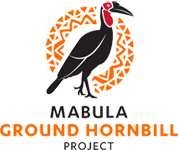Mission Statement & Goals
To slow, then reverse the decline of the Southern Ground-hornbill in South Africa.
Long Term Goals (25 Years)
All MGHP activities are achieved in collaboration with local communities, collaborators and stakeholders with the intention of being a world-class conservation programme.
Goal A:
To secure current ecologically stable SGH population in South Africa, with no concomitant increase in persecution for window-breaking. This will require reducing all current threats – poison, persecution, electrocution, trade and increasing community engagement.
Goal B:
To rebuild, through a trans-disciplinary reintroduction programme based on best-practice and sound peer-reviewed research, SGH populations in areas where they have become locally extinct. These populations will need to rely on natural dispersal rather than being formed as isolated populations needing meta-population management. Focus will be on numerical targets that take into account the species complex social requirements in addition to being physiologically and genetically well chosen. An off shoot of this programme is enhanced awareness about the species plight.
Goal C:
To use the SGH as flagship species for all savanna species. Any successful threat mitigations will thus be beneficial for species such as vultures and Secretary Birds. In addition a locally relevant, sustainable environmental education and skills training program will enhance local landowner participation in conservation and continue to nurture conservation as a career option in these communities, ensuring MGHP is able to help grow conservation capacity in Africa.

Medium Term Goals (2017-2021)
Our six medium term goals are listed below. For each goal we have identified targets and indicators where possible and these are listed in our annual work plan. It is important to bear in mind that this is a rapidly changing environment and these are moving targets as more information is collected and priorities change. In addition in many cases it is difficult to specify a specific target as there is no clear meaningful threshold for what can or should be achieved. In most cases what we are aiming for are positive trends i.e. an increasing population of ground-hornbills, decreasing trend in conflict and, decreasing trend in persecution and poisoning.
Goal 1: Monitor
Provide long-term monitoring of the status of SGH and their threats to assess trends in populations and success of interventions:
Thresholds of Potential Concern.
Continue to collect & collate sighting records DB
Trial provincial monitoring plan: eKZN Wildlife
Extend provincial monitoring to national scale
Health screening: all wild and release birds
Annual nest productivity survey: sub-samples
Genetic screening all wild birds caught
Database: causes of mortality local and international tradeInvolve communities in monitoring
Goal 2: Restore
Reintroduction of sufficient numbers of viable founder groups to build sustainable sub-populations, without using meta-population management and ensuring existing populations maintain sufficient genetic diversity
Improve nest check and harvest protocols
Improve reintroduction stock: Baobab
Complete modelling site selection at population scale.
Complete reintroduction plan – IUCN
Complete risk assessment
Improve site assessments and recognition of likely threats for mitigation
Improve reintroduction techniques
Ensure adequate monitoring and site management (nest, habitat) as per plan
Ensure adequate management conditioning of release stock.
Increase and maintain stakeholder engagement and relationships
Goal 3: Mitigate
Reduce direct human impacts (abusive use of pesticides, lead poisoning, snaring, electrocution, trade) and reduce conflict (window-breaking) by developing and implementing sustainable and effective solutions in collaboration with local communities, NGO,s, provincial and national conservation bodies.
Reduce lead ammunition in landscape
Reduce abusive use of pesticides
Work with ESKOM to insulate transformer boxes
Work with traditional healers towards solutions for local trade
Investigate mitigations for window-breakingProvision of artificial nests nationally
Goal 4: Research
Lead, collaborate in, support and encourage research into aspects of the ecology of the species relevant to their conservation management and ensure this information is easily available.
Complete genetic analysisHormone drivers: captive and stress
Vocalisations Cultural significance to guide custodianship
Critical habitat and density
Vaccine development
Novel threats
Artificial nest development
Analysis of hand-rearing techniques & successes
Egg density
Goal 5: Educate
Ensure effective education programme reach all intended release zones and remaining wild population beyond the protection of protected areas.
National curriculum-based programme
All schools annually 50 km buffer release sites
Continue to expand outreach to areas where wild groups persist.
Research impact of awareness programme.
Popularise science of speciesIncrease media scope: TV, radio, social
Use of species as flagship to introduce wider conservation ethics to communities.
Use community outreach to increase tolerance and reduce conflict.
Provide locally relevant conservation material.
Goal 6: Be better
Improve and retain capacity, efficiency and stability of MGHP to enable it to continue to make a long-term contribution to conservation in South Africa and beyond. Build local capacity nationally, and regionally, though provision of training, mentorship and where possible funding.
Increase awareness of MGHP work and importance of SGH to a broader audience both nationally and internationally
Secure long-term funding
Internship for capacity building requirements
Maintain highest conservation ethical codesImprove and streamline the business and logistical management of MGHP
To provide long term monitoring of the status and threats to assess our effectiveness and allow us to adaptively manage change.
Mentor, guide and train conservationists and staff and encourage staff participation in the project.
